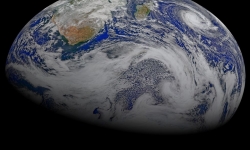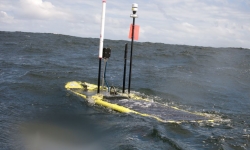Groundbreaking research shows storms drive outgassing of CO2 in the subpolar Southern Ocean
The subpolar sector of the Southern Ocean plays an important role in the global carbon budget. However, while, researchers have linked the occurrence of widespread outgassing of CO2 in this region to the large-scale upwelling of old CO2-rich deep waters, the mechanisms that explain their transport into the surface mixed-layer, where it can then be outgassed into the atmosphere, remain poorly understood.
In the study, the researchers highlight the importance of the frequent strong storms in modulating the mean seasonal transport of CO2 within and across the mixed-layer and surface ocean boundary interfaces.
New research that was published in an article in Nature Communications on 10 January 2022 has shown, through new high-resolution observations using ocean robotics, that the impact of storms on ocean mixing is critical to understanding the present and future of the Southern Ocean carbon dioxide (CO2) sink. This research was led by CSIR scientists Dr Sarah Nicholson and Dr Pedro Monteiro from the Southern Ocean Carbon-Climate Observatory (SOCCO), working with a team of international scientists from the National Center for Atmospheric Research, United State of America (USA), NOAA Pacific Marine Environmental Laboratory (USA), University of Cape Town, University of Bergen (Norway), and University of Gothenburg (Sweden).
The subpolar sector of the Southern Ocean plays an important role in the global carbon budget. However, while, researchers have linked the occurrence of widespread outgassing of CO2 in this region to the large-scale upwelling of old CO2-rich deep waters, the mechanisms that explain their transport into the surface mixed-layer, where it can then be outgassed into the atmosphere, remain poorly understood.
In the study, the researchers highlight the importance of the frequent strong storms in modulating the mean seasonal transport of CO2 within and across the mixed-layer and surface ocean boundary interfaces.
“Our study looks to address gaps in the understanding of how the short (1-10-day) timescales of storms influence CO2 fluxes on seasonal to longer timescales and their sensitivity to climate change in this important region. Through the SOCCO-led Southern Ocean Seasonal Cycle Experiment, we deployed multiple ocean robots, known as gliders, equipped with CSIR-designed and built pCO2 instruments that sampled the atmosphere-ocean interface and the mixed-layer simultaneously. Our experiment showed that storm-driven ocean mixing and advection explains the substantial CO2 variability and outgassing in this region. Storms drive deep mixing events (as deep as 150 m) that "tap" into the upwelled reservoir of CO2-rich waters, driving strong outgassing events that may cumulatively influence the mean flux of CO2 in this critical region. Storm characteristics (e.g., their annual occurrence, location and intensity) are changing, so understanding their role in this region is important for predicting future changes in the global carbon budget. These processes are currently not appropriately captured by Earth System Models,” Nicholson says.
The results support the hypothesis advanced in the three-year SOCCO science plan, that storm-driven ocean physics is a significant participant in the Southern Ocean carbon cycle.
The study was made possible by the sustained financial support from the South African Department of Science and Innovation, the National Research Foundation, the CSIR and strategic international collaborations.
“We will continue to strengthen the CSIR-SOCCO impact on human capital development, science and innovation through research excellence and sustained international collaborations. Our goal is to have Africa play a stronger role at the forefront of science and contribute groundbreaking work at the ocean-climate interface,” Monteiro concludes.
The paper has been published online at https://www.nature.com/articles/s41467-021-27780-w#Sec5



